The Italian island that has received 12,000 people in search of a new life this week is also home to a thriving leisure industry that welcomes 30,000 travelers every year
/cloudfront-eu-central-1.images.arcpublishing.com/prisa/YK6Z7PWPGNHD7MU4JSWPGRCR4A.png)
A boat with migrants surrounded by yachts with tourists, this past Monday in Lampedusa.
CECILIA FABIANO/LAPRESSE
LORENA PACHO
Lampedusa - SEP 19, 2023
The Italian coast guard rescues, off the coast of Lampedusa, a drifting barge loaded with migrants trying to reach Europe through the Mediterranean. They are transferred to a military ship and taken to the port. At the dock, they will be identified and treated by doctors. Then they will go to the buses that will take them to the reception center, where they will stay for a few days until they leave the island on a boat heading to the reception centers in Sicily or the mainland. To the tourists who, a few feet from the landing area, mix with the locals in the urban center — full of bars with terraces and shops — after a day at the beach, in the bustle of a September Sunday afternoon (still high season in Lampedusa), they are barely ghosts.
The beaches, restaurants, and hotels are still full. In the most prosperous years, up to 30,000 tourists, mostly Italian, come to this island of about 6,000 residents. There is no data to suggest that immigration harms in any way the economic activity of Lampedusa.
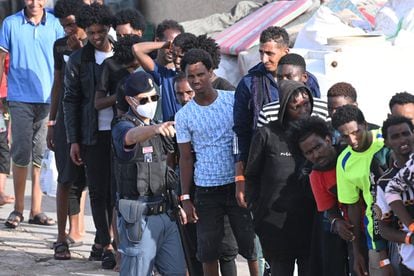
A group of migrants arriving this past Monday in Lampedusa
.CIRO FUSCO (EFE)
On summer nights, the streets of the center of the island become an open-air party, with concerts that go on well into the early hours of the morning and souvenir shops still open after midnight. Not far from there, in the church square, long lines of migrants wait to receive a plate of hot food. Although this happens almost every day, they do not come across the tourists, who dine on the terraces of nearby restaurants.
This week has been unusual in every sense. Nearly 12,000 migrants arrived in Lampedusa in just a few days, and the exception that proves the rule occurred: a group of boys from the Gambia, Liberia, Ivory Coast and Nigeria who had just landed on the island danced with tourists and locals to the rhythm of Bob Marley’s reggae. This almost never happens. But most of the neighbors, who have gone out of their way to bring clothes, blankets, water and food, celebrate it as a sign of welcome and normality.
Two reception systems coexist in Lampedusa: one for tourists and one for migrants arriving through the Mediterranean. Some see the island as a holiday paradise. For others, who are fleeing hunger, natural disasters or war, it represents the gateway to Europe, the end of a dangerous sea voyage in which they risk their lives. To date, the International Organization for Migration (IOM) estimates that more than 2,000 people who left North Africa trying to reach Italy have died in the central Mediterranean.
On summer nights, the streets of the center of the island become an open-air party, with concerts that go on well into the early hours of the morning and souvenir shops still open after midnight. Not far from there, in the church square, long lines of migrants wait to receive a plate of hot food. Although this happens almost every day, they do not come across the tourists, who dine on the terraces of nearby restaurants.
This week has been unusual in every sense. Nearly 12,000 migrants arrived in Lampedusa in just a few days, and the exception that proves the rule occurred: a group of boys from the Gambia, Liberia, Ivory Coast and Nigeria who had just landed on the island danced with tourists and locals to the rhythm of Bob Marley’s reggae. This almost never happens. But most of the neighbors, who have gone out of their way to bring clothes, blankets, water and food, celebrate it as a sign of welcome and normality.
Two reception systems coexist in Lampedusa: one for tourists and one for migrants arriving through the Mediterranean. Some see the island as a holiday paradise. For others, who are fleeing hunger, natural disasters or war, it represents the gateway to Europe, the end of a dangerous sea voyage in which they risk their lives. To date, the International Organization for Migration (IOM) estimates that more than 2,000 people who left North Africa trying to reach Italy have died in the central Mediterranean.
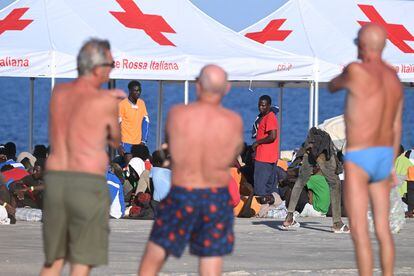
Tourists watch a group of migrants in Lampedusa on September 15.
CIRO FUSCO (EFE)
Nevertheless, a tourist could spend weeks on the island without ever knowing what is taking place just a short distance away. Everything is organized so that the immigration issue does not interfere with local life. “There are two parallel channels that do not intersect. When everything is working normally, tourists don’t see migrants. These days of emergency there were migrants on the streets, asking peacefully for food, water. Some chose to offer them assistance, while others chose not to,” Giusi Nicolini, former mayor of Lampedusa, explains to EL PAÍS.
In general, many people who live or work in Lampedusa explain that there are very few points where the experiences of those who arrive by sea on an iron barge coincide with those of the rest of the people on the island.
The reception center is located approximately 1.5 miles from the port, nestled on a small hill, in an area with no hotels or vacation homes. Less than half a mile away, there is a landfill. Seeing the place from the central streets with the naked eye is impossible. In the urban area of Lampedusa, populated by a swarm of sun-drenched low houses, a mural depicts the drama that migrants go through when they take to the sea to reach Europe.
Filippo Mannino, the head of a right-wing coalition, has been the mayor of Lampedusa for a little over a year. Among other things, he has kept in force an ordinance that prohibits people housed in the reception center from leaving the premises. This rule was implemented in 2020 due to the pandemic, and, even though the health reasons no longer apply, the politician decided to maintain it. Currently, only those who have the strength to jump the fence and elude the army — which patrols the outside of the facility — can leave the reception center.
Nevertheless, a tourist could spend weeks on the island without ever knowing what is taking place just a short distance away. Everything is organized so that the immigration issue does not interfere with local life. “There are two parallel channels that do not intersect. When everything is working normally, tourists don’t see migrants. These days of emergency there were migrants on the streets, asking peacefully for food, water. Some chose to offer them assistance, while others chose not to,” Giusi Nicolini, former mayor of Lampedusa, explains to EL PAÍS.
In general, many people who live or work in Lampedusa explain that there are very few points where the experiences of those who arrive by sea on an iron barge coincide with those of the rest of the people on the island.
The reception center is located approximately 1.5 miles from the port, nestled on a small hill, in an area with no hotels or vacation homes. Less than half a mile away, there is a landfill. Seeing the place from the central streets with the naked eye is impossible. In the urban area of Lampedusa, populated by a swarm of sun-drenched low houses, a mural depicts the drama that migrants go through when they take to the sea to reach Europe.
Filippo Mannino, the head of a right-wing coalition, has been the mayor of Lampedusa for a little over a year. Among other things, he has kept in force an ordinance that prohibits people housed in the reception center from leaving the premises. This rule was implemented in 2020 due to the pandemic, and, even though the health reasons no longer apply, the politician decided to maintain it. Currently, only those who have the strength to jump the fence and elude the army — which patrols the outside of the facility — can leave the reception center.
Protesting the government management
Recently, Mannino suggested, without evidence, that if the management of immigrants is too visible, it becomes detrimental to tourism. “The goal of the government and this administration must be to minimize the impact of the reception in this territory, because we actually live from tourism and we want to continue living from it,” he stated. The vice mayor, Attilo Lucia, has echoed this message and has encouraged the locals to protest against Rome’s migration management.
The former mayor, Giusi Nicolini (who a decade ago, in the midst of the refugee crisis, exported an exciting message of welcome that was replicated by many local governments of Europe) rejects that vision. “The presence of migrants is not a problem; if that was the case, this island would be at risk of depopulation. Instead, it is a place that is growing demographically and where profits from tourism are increasing more and more. In fact, it is a positive example that shows that coexistence is possible, and that welcoming people harms no one,” she says.
“We came to spend a few days relaxing at the sea. We met a group of boys asking for food and water. We gave it to them and chatted with them for a while. We learned their stories. It was going to be a normal vacation, and it became an enriching experience,” says Ilaria Benedetti, a Roman tourist who visited the island with her husband and two children.
Many local workers do not think that immigration will affect the island’s image. “We barely see the migrants, because they arrive in the boats, and they’re taken directly from the port to the reception center. Their arrival does not affect tourism in any way, why would it? Hotels and restaurants continue to hang signs announcing that they are full; that is the proof,” says Emanuele, a taxi driver. “Immigration and tourism are different things,” agrees Luciana, who works in a craft store.
One of the few places where tourists and migrants do meet is the island’s outpatient clinic, which is divided into three sections: one for the locals, the emergency section for tourists (active from mid-June to mid-September) and the unit that cares for migrants. The three sections are located in different parts of the outpatient clinic, but they share the same waiting room. Here, a tourist injured by a jellyfish on the beach and a woman arriving from Libya with signs of violence after months in immigration detention centers can find themselves sitting next to each other.
The island’s small cemetery is another space that everyone shares. There, the graves of the migrants who lost their lives in the water are not far from the rest. For years (until it ran out of space) some foreign victims of the sea were buried there in unmarked graves that read: “Here lies an unidentified immigrant.” Someone left flowers and a small wooden boat on them, and decorated them with drawings. The IOM estimates that, since 2014, approximately 17,000 people have disappeared in the waters of the Mediterranean while trying to reach Europe.
Ten years after tragedy, tiny Lampedusa at centre of migration crisis again
More than 11,000 people have landed on the island in recent days – a decade on from when hundreds were killed in a shipwreck
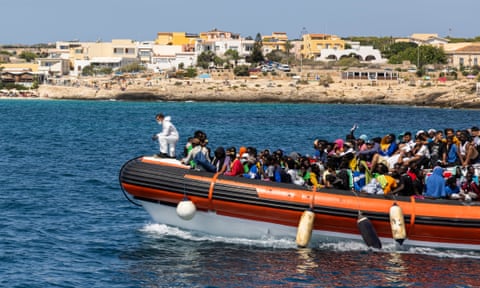
An Italian coastguard boat packed with people in the port of the Italian island of Lampedusa. Photograph: Roberto Salomone/The Guardian
by Angela Giuffrida in Lampedusa
Wed 20 Sep 2023
Vito Fiorino and his friends were preparing to go fishing after sleeping the night on his boat docked off Lampedusa when one of them, Alessandro, heard piercing screams. It was about 6am on 3 October 2013. The group often ventured out to sea on the abandoned boat that Fiorino had brought back to life after moving to the tiny Sicilian island a few years earlier. But rarely would they spend the night.
“It was a dark night with lots of stars, no wind and a beautiful sea, and so we decided to sleep on the boat, something we hadn’t done in years,” Fiorino said. “Alessandro got the boat going as dawn broke and after a few metres stopped the engine and asked: ‘Did you hear that noise?’ He used a Sicilian word which means ‘cries of anguish’. There was a huge flock of seagulls so I was convinced that the noise was coming from them.”

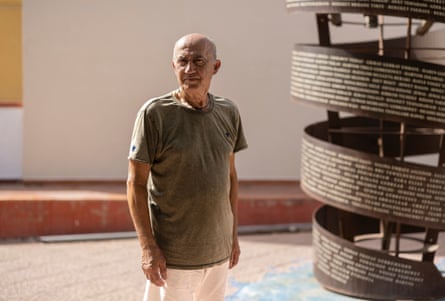

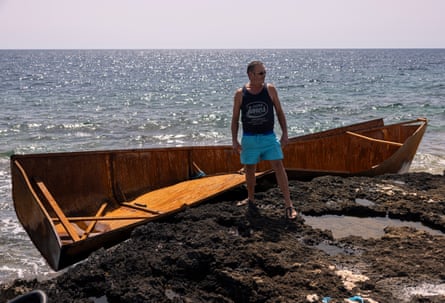

More than 11,000 people have landed on the island in recent days – a decade on from when hundreds were killed in a shipwreck

An Italian coastguard boat packed with people in the port of the Italian island of Lampedusa. Photograph: Roberto Salomone/The Guardian
by Angela Giuffrida in Lampedusa
Wed 20 Sep 2023
Vito Fiorino and his friends were preparing to go fishing after sleeping the night on his boat docked off Lampedusa when one of them, Alessandro, heard piercing screams. It was about 6am on 3 October 2013. The group often ventured out to sea on the abandoned boat that Fiorino had brought back to life after moving to the tiny Sicilian island a few years earlier. But rarely would they spend the night.
“It was a dark night with lots of stars, no wind and a beautiful sea, and so we decided to sleep on the boat, something we hadn’t done in years,” Fiorino said. “Alessandro got the boat going as dawn broke and after a few metres stopped the engine and asked: ‘Did you hear that noise?’ He used a Sicilian word which means ‘cries of anguish’. There was a huge flock of seagulls so I was convinced that the noise was coming from them.”

A boat full of tourists leaves the port of Lampedusa. In the foreground the boats used by migrants to reach the island. Photograph: Roberto Salomone/The Guardian
Instead of fishing, they sailed further out to sea to explore where the sound was coming from. “After navigating for 800 metres, what I saw in front of me was terrifying,” Fiorino said. “There were about 200 people in the sea, screaming and crying for help.”
Fiorino’s 10-metre boat, called Gama, was the first to arrive on the scene after a flimsy vessel crammed with almost 500 people caught fire and sank not far from the shore of Lampedusa’s famed Rabbit beach.
The bodies of 368 people were recovered in what was one of the Mediterranean’s worst shipwrecks. It was also one of the most shameful episodes for Italy, whose coastguard had ignored repeated SOS calls, and for the EU.
Now, as the 10th anniversary of the tragedy nears, Lampedusa – for years the first port of call for people making the perilous journey by sea from north Africa – and the memories of that night have been thrust back into the spotlight after more than 11,000 people, almost double the island’s population, landed on the island within six days.
Instead of fishing, they sailed further out to sea to explore where the sound was coming from. “After navigating for 800 metres, what I saw in front of me was terrifying,” Fiorino said. “There were about 200 people in the sea, screaming and crying for help.”
Fiorino’s 10-metre boat, called Gama, was the first to arrive on the scene after a flimsy vessel crammed with almost 500 people caught fire and sank not far from the shore of Lampedusa’s famed Rabbit beach.
The bodies of 368 people were recovered in what was one of the Mediterranean’s worst shipwrecks. It was also one of the most shameful episodes for Italy, whose coastguard had ignored repeated SOS calls, and for the EU.
Now, as the 10th anniversary of the tragedy nears, Lampedusa – for years the first port of call for people making the perilous journey by sea from north Africa – and the memories of that night have been thrust back into the spotlight after more than 11,000 people, almost double the island’s population, landed on the island within six days.

Vito Fiorino was among the first responders when a boat full of migrants capsized on 3 October 2013, causing one of the worst shipwrecks ever in the Mediterranean Sea. Photograph: Roberto Salomone/The Guardian
Lives have again been lost: on Saturday, the body of a baby who died shortly after being born onboard a boat carrying 40 passengers was placed in a white coffin and taken to the island’s cemetery, where the remains of other people who perished making the journey over the years are buried in unmarked graves. Last week, a five-month-old boy drowned during a rescue operation.
Fiorino and his friends managed to save 47 people in the 2013 shipwreck before the coastguard arrived. When the then prime minister, Enrico Letta, visited the island soon after, he was heckled. There was a similar reaction on Sunday when residents disrupted a convoy transporting the current premier, Giorgia Meloni, and Ursula von der Leyen, the president of the European Commission, to the island’s overcrowded reception centre.
Lives have again been lost: on Saturday, the body of a baby who died shortly after being born onboard a boat carrying 40 passengers was placed in a white coffin and taken to the island’s cemetery, where the remains of other people who perished making the journey over the years are buried in unmarked graves. Last week, a five-month-old boy drowned during a rescue operation.
Fiorino and his friends managed to save 47 people in the 2013 shipwreck before the coastguard arrived. When the then prime minister, Enrico Letta, visited the island soon after, he was heckled. There was a similar reaction on Sunday when residents disrupted a convoy transporting the current premier, Giorgia Meloni, and Ursula von der Leyen, the president of the European Commission, to the island’s overcrowded reception centre.

People lie on the ground in Lampedusa waiting to board a ship that will transfer them to Sicily. Photograph: Roberto Salomone/The Guardian
“People are frustrated because in the space of 10 years, nothing has changed,” Fiorino said. “We hear a lot of words, but they are all empty.”
More than 127,000 people have landed on Italian soil so far in 2023 – more than double the number over the same period last year. The majority have set off from Tunisia, where in July Meloni and Von der Leyen signed a controversial £105m deal to stem irregular migration.
Lampedusa, which lies closer to Tunisia than mainland Italy and survives off fishing and tourism, has once again been shouldering most of the burden.
“People are frustrated because in the space of 10 years, nothing has changed,” Fiorino said. “We hear a lot of words, but they are all empty.”
More than 127,000 people have landed on Italian soil so far in 2023 – more than double the number over the same period last year. The majority have set off from Tunisia, where in July Meloni and Von der Leyen signed a controversial £105m deal to stem irregular migration.
Lampedusa, which lies closer to Tunisia than mainland Italy and survives off fishing and tourism, has once again been shouldering most of the burden.

Alfonso Gagliano, who last April rescued migrants who risked drowning a few miles from the coast of the Italian island of Lampedusa. Photograph: Roberto Salomone/The Guardian
“We will always save lives but we feel abandoned,” said Alfonso Gagliano, a fisher who in April rescued a group of people at sea. “Unfortunately, these frequent arrivals affect us a lot – our livelihoods, healthcare, everything … we just don’t have the services to cope.”
Meloni, who renewed vows to get tough on illegal immigration, said Von der Leyen’s trip to Lampedusa was “a sign of responsibility, not solidarity”. Yet they were spared the scenes of the humanitarian crisis that had played out on the island in the days before their visit.
There had been chaos at the reception centre, which has the capacity to host 400 people, with some sleeping along the rubbish-strewn street that leads up to the facility. Those inside, desperate to find food, tried to climb over a fence. The many who had not got a spot in the centre, which in the past has been criticised for its appalling conditions, bedded down on benches and under trees close to the island’s main thoroughfare, Via Roma.
“Why is it you people think we don’t have a right to refuge or respect?” said Amadou, who was among five young people from the Gambia stranded outside the reception centre on Saturday afternoon. “We are educated, we have studied languages – all we want is a better life.”
By the time Meloni and Von der Leyen arrived the next morning, the majority of people had been transferred off the island to centres in Sicily or mainland Italy, and the area around the reception centre, which the pair toured for about 10 minutes, had been made to look almost pristine.

“We will always save lives but we feel abandoned,” said Alfonso Gagliano, a fisher who in April rescued a group of people at sea. “Unfortunately, these frequent arrivals affect us a lot – our livelihoods, healthcare, everything … we just don’t have the services to cope.”
Meloni, who renewed vows to get tough on illegal immigration, said Von der Leyen’s trip to Lampedusa was “a sign of responsibility, not solidarity”. Yet they were spared the scenes of the humanitarian crisis that had played out on the island in the days before their visit.
There had been chaos at the reception centre, which has the capacity to host 400 people, with some sleeping along the rubbish-strewn street that leads up to the facility. Those inside, desperate to find food, tried to climb over a fence. The many who had not got a spot in the centre, which in the past has been criticised for its appalling conditions, bedded down on benches and under trees close to the island’s main thoroughfare, Via Roma.
“Why is it you people think we don’t have a right to refuge or respect?” said Amadou, who was among five young people from the Gambia stranded outside the reception centre on Saturday afternoon. “We are educated, we have studied languages – all we want is a better life.”
By the time Meloni and Von der Leyen arrived the next morning, the majority of people had been transferred off the island to centres in Sicily or mainland Italy, and the area around the reception centre, which the pair toured for about 10 minutes, had been made to look almost pristine.

People wait to board a ship that will transfer them on the mainland. Photograph: Roberto Salomone/The Guardian
“They really didn’t see anything of the inhumanity,” said Mariangela Greco, a B&B owner. “Neither do they understand the issues we have to deal with.”
Residents empathise with the arrivals – they have rallied to provide clothing and food, with restaurants offering meals and one elderly woman cooking for people in her home. But they feel that their own problems, including bad roads, poor waste management and a hospital bereft of a maternity unit, are being ignored as they are left to deal with a phenomenon that is showing no sign of subsiding. People continue to arrive – more than 700 since Monday.
Greco was among the residents protesting over fears that the island will be transformed into a so-called “tent city”, even more so after Meloni’s far-right government approved a measure on Monday night giving power to authorities to detain those turned down for asylum in reception centres for as long as 18 months.
“We believe they want to provide tents for 3,000 people – we will not allow it,” Greco said. “The island is too small for something so big and will ruin everything – we survive off tourism and fishing, but mostly tourism.”
After the 2013 disaster, there were fears that tourists would stop coming. Instead, visitor numbers have increased, with new hotels springing up in recent years and more flights to the island.
“They really didn’t see anything of the inhumanity,” said Mariangela Greco, a B&B owner. “Neither do they understand the issues we have to deal with.”
Residents empathise with the arrivals – they have rallied to provide clothing and food, with restaurants offering meals and one elderly woman cooking for people in her home. But they feel that their own problems, including bad roads, poor waste management and a hospital bereft of a maternity unit, are being ignored as they are left to deal with a phenomenon that is showing no sign of subsiding. People continue to arrive – more than 700 since Monday.
Greco was among the residents protesting over fears that the island will be transformed into a so-called “tent city”, even more so after Meloni’s far-right government approved a measure on Monday night giving power to authorities to detain those turned down for asylum in reception centres for as long as 18 months.
“We believe they want to provide tents for 3,000 people – we will not allow it,” Greco said. “The island is too small for something so big and will ruin everything – we survive off tourism and fishing, but mostly tourism.”
After the 2013 disaster, there were fears that tourists would stop coming. Instead, visitor numbers have increased, with new hotels springing up in recent years and more flights to the island.

Alessio and Elena Pewvitali, tourists, portrayed on la Guitgia beach in Lampedusa. Photograph: Roberto Salomone/The Guardian
Beaches remained packed in recent days. “I felt guilty eating while seeing people who were hungry,” said Elena Previtali, who was enjoying the late afternoon sun on a beach metres away from a port where people continued to arrive. “It is a desperate situation that is badly managed.”
With the devastating floods in Libya and earthquake in Morocco, there will be “another wave of desperate people coming to Europe,” said her husband, Alessio.
“There is no magic wand to resolve the situation,” he said. “Either way, it involves Europe, not just Italy.
Beaches remained packed in recent days. “I felt guilty eating while seeing people who were hungry,” said Elena Previtali, who was enjoying the late afternoon sun on a beach metres away from a port where people continued to arrive. “It is a desperate situation that is badly managed.”
With the devastating floods in Libya and earthquake in Morocco, there will be “another wave of desperate people coming to Europe,” said her husband, Alessio.
“There is no magic wand to resolve the situation,” he said. “Either way, it involves Europe, not just Italy.

No comments:
Post a Comment